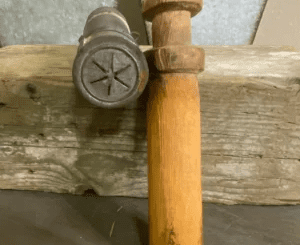The Stanley Smooth Wood Plane is a cherished hand tool that has played a pivotal role in woodworking for over a century. With its origins deeply rooted in the evolution of craftsmanship, this tool has not only transformed woodworking practices but has also become a symbol of quality and precision in the field. From its historical beginnings to its modern-day applications, the Stanley Smooth Wood Plane remains an essential tool for both professional woodworkers and hobbyists. Let’s journey through the fascinating history, usage, and enduring legacy of this iconic tool.
A Brief History of the Stanley Smooth Wood Plane

The wood plane has been an integral part of woodworking since ancient times, with early versions found in Roman ruins. However, the Stanley Smooth Wood Plane, as we recognize it today, owes its sophistication and durability to developments made in the 19th century.
The Birth of the Stanley Rule and Level Company
The story of the Stanley Smooth Wood Plane begins with the establishment of the Stanley Rule and Level Company in 1857 by Frederick T. Stanley in New Britain, Connecticut. Initially, the company produced hardware items, but it quickly expanded to meet the growing demand for reliable and high-quality woodworking tools. Recognizing the need for better woodworking equipment, Stanley ventured into hand tool manufacturing, setting the stage for their renowned line of wood planes.
Leonard Bailey’s Innovations
A significant turning point for Stanley came in 1869 when the company acquired patents from Leonard Bailey, a talented toolmaker known for his advanced designs of metal-bodied planes. Bailey’s innovations were transformative, as they introduced adjustability and strength that traditional wooden planes lacked. This acquisition allowed Stanley to dominate the hand tool market and redefine woodworking tools. Bailey’s designs became the foundation for what would later become the most popular line of hand planes in history: the Stanley Bailey line.
The Rise of the Bailey Line
The Bailey line, named after Leonard Bailey, includes various types of planes for different woodworking tasks, such as block planes, jointer planes, and, of course, the smooth plane. Among these, the Stanley No. 4 Smooth Plane quickly became a standout model due to its versatility and precision. Over the years, it has become the go-to tool for creating a perfectly smooth finish, making it a favorite among woodworkers.
How to Use the Stanley Smooth Wood Plane
The Stanley Smooth Wood Plane is designed to remove thin layers of wood, creating a polished, flat surface. Let’s break down its components and usage to understand why this tool is so effective.
Key Components and Their Functions
A typical Stanley Smooth Wood Plane consists of several essential parts:
- Body: The main structure, typically made from cast iron, provides stability and weight, which helps keep the plane steady during use.
- Iron (Blade): A sharp blade, or iron, is responsible for cutting the wood. Its angle can be adjusted to control the depth and smoothness of each pass.
- Frog: This metal piece holds the iron at the proper angle and allows for fine adjustments to the blade’s depth.
- Cap Iron: Secures the blade and reduces chatter by minimizing vibration as the plane moves over the wood.
- Lever Cap: Holds both the iron and cap iron firmly in place, ensuring a stable cut.
- Handle (Tote) and Knob: These provide a comfortable grip and control, making it easier to guide the plane with precision.
Steps to Using the Stanley Smooth Wood Plane

- Adjustment: Begin by setting the blade’s depth and angle using the adjustment mechanisms. The blade should be just slightly exposed to remove thin shavings with each pass.
- Planing: Hold the plane firmly, with one hand on the front knob and the other on the rear handle (tote). Push the plane along the wood grain in smooth, even strokes. Maintain steady pressure to ensure a consistent finish.
- Inspection: After a few passes, check the wood surface for smoothness. Adjust the blade depth if needed, and continue planing until you achieve the desired finish.
Versatility in Woodworking
The Stanley Smooth Wood Plane is celebrated for its versatility. It’s used for various woodworking tasks, each requiring a slightly different approach. Here’s how this tool can be applied in multiple scenarios:
Smoothing Rough Surfaces
One of the plane’s primary functions is to smooth out rough lumber. It removes minor imperfections and prepares the wood for finishing, resulting in a beautifully polished surface.
Jointing Edges

When preparing boards for edge joining, the Stanley Smooth Wood Plane helps ensure straight, even edges. This is especially useful when joining multiple boards to create a wider surface, as it helps eliminate gaps and misalignments.
Trimming and Shaping
The plane is excellent for adjusting dimensions and shaping curves. It allows woodworkers to trim off excess material with precision, making it an essential tool for custom projects.
Adding Finishing Touches
For final touches, the Stanley Smooth Wood Plane helps enhance the appearance of a finished piece. Whether it’s a tabletop, cabinet, or decorative piece, the plane gives wood a smooth, professional finish.
The Lasting Legacy of the Stanley Smooth Wood Plane
The Stanley Smooth Wood Plane’s legacy is a testament to its enduring quality and versatility. Despite the rise of power tools, many woodworkers still prefer the tactile control and precision that a hand plane offers.
Enduring Popularity Among Woodworkers
The Stanley No. 4 Smooth Plane remains a beloved tool among both professionals and enthusiasts. Its balanced design and effectiveness make it indispensable for those who value craftsmanship. Many woodworkers argue that no power tool can truly replicate the feel and finesse of using a well-maintained hand plane.
Influence on Modern Tool Design

Stanley’s influence on modern tools is undeniable. Today’s hand planes draw inspiration from Stanley’s designs, incorporating advanced materials and engineering while retaining the fundamental principles that made Stanley tools iconic. The Bailey line’s legacy is visible in countless contemporary woodworking tools.
Collectible and Valuable Antiques
Vintage Stanley planes have become sought-after collectibles, cherished for their historical significance and enduring craftsmanship. Many early models fetch high prices at auctions and antique shops, reflecting the lasting value of these tools. Collectors and woodworkers alike appreciate the role Stanley planes have played in woodworking history.
A Symbol of Craftsmanship
The Stanley Smooth Wood Plane represents more than just a woodworking tool; it embodies the dedication and artistry of skilled craftsmen throughout history. Each plane stroke is a connection to a time when hand tools were essential for creating beautiful, lasting works of art. Whether it’s the first pass on a rough board or the final touch on a polished surface, the Stanley Smooth Wood Plane reminds us of the timeless pursuit of perfection in woodworking.
Conclusion: The Stanley Smooth Wood Plane’s Enduring Impact
The Stanley Smooth Wood Plane has rightfully earned its place in woodworking history. Its innovative design, versatile usage, and lasting legacy make it a cherished tool for woodworkers around the world. Whether you’re a seasoned craftsman or a passionate hobbyist, the Stanley Smooth Wood Plane continues to inspire excellence, inviting us all to embrace the art of woodworking with every stroke.


